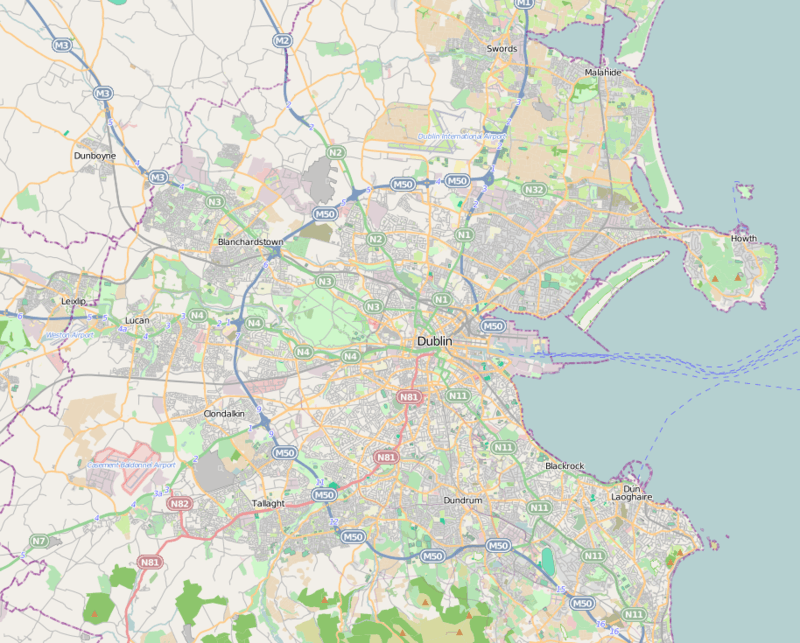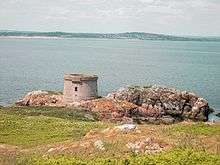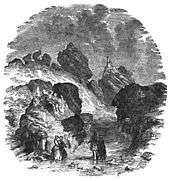Ireland's Eye
Ireland's Eye (Irish: Inis Mac Neasáin[1]) is a small uninhabited island off the coast of County Dublin, Ireland, situated directly north of Howth Harbour. The island is easily reached by regular tourist boats. The island is currently part of the county of Fingal, for administrative purposes, but was at one time part of the city of Dublin. The island was for centuries part of the Howth Estate, but was sold to the Tetrarch investment group in a deal announced in 2018.
| Native name: Inis Mac Neasáin | |
|---|---|
 Ireland's Eye from Howth Harbour | |
 Ireland's Eye | |
| Geography | |
| Location | Irish Sea |
| Coordinates | 53°24′19″N 6°03′49″W |
| Area | 0.22 km2 (0.085 sq mi) |
| Administration | |
| Province | Leinster |
| County | Dublin |
| Local authority | Fingal County Council |
| Demographics | |
| Population | 0 (2016) |
| Additional information | |
| Owner: Tetrarch Investment Group | |

History

In Celtic times the island was called Eria's Island. Eria was a woman's name and this became confused with Erin, derived from Éireann, the Irish name for Ireland. The Vikings substituted the word Island with ey, their Norse equivalent, and so it became known as Erin's Ey and ultimately Ireland's Eye. The island was also known formerly as Inis Faithlenn.[2][3]
The Garland of Howth manuscript is said to have been mostly written at the abbey on the island sometime between the 8th and 10th century.
The island was the original site of the village's church, and also an early element of the Howth estate when the St Lawrence family took over the area.
A Martello tower was built in 1803.
In September 1852 a woman named Sarah Maria Louisa Kirwan was killed on the island; her husband, artist William Burke Kirwan, was convicted of her murder.[4][5] Matthias McDonnell Bodkin claimed in Famous Irish Trials that no murder had taken place, instead that Sarah Kirwan had drowned accidentally as a result of a fit.[6]
In June 2015 a large portion of Ireland's Eye was scorched by gorse fires.[7]
In October 2018, the Gaisford-St.Lawrence family announced their agreement to sell Howth Castle and demesne, and Ireland's Eye, to the Tetrarch investment group, as part of a multi-million euro deal, and for the first time in many hundred years the freehold of the island passed outside of the family of the Lords of Howth.[8][9]
Nature
Geology and structure
Ireland's Eye comprises the main island, a range of rocks and an islet called Thulla. The most spectacular feature is the huge freestanding rock called "the Stack", at the northeastern corner of the island.
The island has one regular spring, located near the site chosen for the Martello Tower.
Fauna and flora
The island as a whole and especially the Stack, play host to a large variety of seabirds, including thousands of guillemots, razorbills, fulmars and gulls. Ireland's fifth gannet colony became established on the Stack in the 1980s, and there are now a few hundred pairs breeding there each year. There is a large cormorant colony on the main island, and a few breeding pairs of puffins.
Grey seals are abundant in the sea around the island.
Buildings
The ruins of a Martello tower and an 8th-century church (the Church of the Three Sons of Nessan)[10] are the only signs of previous habitation.
The church functioned as parish church for Howth until recent centuries, eventually being replaced by a church in the village due to the limitations of having to take a boat for every service.
The Martello Tower, built in 1803, was one of three constructed in the Howth area, on the instructions of the Duke of York to repel a possible invasion by Napoleon. Its window entrance, 5 metres above ground level, can be accessed by a rope that hangs down from the window.
Jurisdiction
Ireland's Eye lies within the historic County Dublin, and is now in the jurisdiction of Fingal County Council; it was at one point in the past within the jurisdiction of the City of Dublin. It is in the civil parish of Howth, and the barony of Coolock. It is a townland in its own right, with a registered area of 21.5 hectares (53 acres).
Access and leisure
Ireland's Eye is served by two small boat companies from Howth Harbour in the summer months, and some visitors access it with their own craft. As of 2020, access to the island has never been restricted and there is no admission charge. Other tourist boat services navigate around the island, but do not dock.
The island has long been established as a minor rock-climbing location.[11] About 28 routes have been recorded since the 1940s, though it is believed that climbers have operated on the island since the 1910s or before. Climbing does not take place during the seabird nesting season of April to July.[12][13]
Sources
- Statutory Instrument 900 of 2004, Inis Mac Neasain SPA Order. Dublin: Government Publications Office (for the Houses of the Oireachtas). 2004.
- Todd, James Henthorn (1867). Cogad Gáedel re Gallaib. p. lxxxiii.
- Hogan, Edmund (1910). Onomasticon Goedelicum. Dublin: Hodges Figgis. Retrieved 11 July 2018.
- "The Ireland Eye Case – Trial of Mr William Burke Kirwan". Anglo-Celt. Cavan. 16 December 1852. Retrieved 11 July 2018.
- "The "Ireland's Eye" Murder" (PDF). New York Times. 15 January 1853. Retrieved 11 July 2018.
- Bodkin, Matthias McDonnell. Famous Irish Trials. Archived from the original on 24 February 2012. Retrieved 11 July 2018.
- "Ireland's Eye was badly scorched by raging gorse fires". The Journal. 25 June 2015. Retrieved 11 July 2018.
- Tetrarch buys 470 acres in Howth including its castle and former hotel Irish Times, 2018-10-05.
- "Glenveagh - 2019 Interim Results". www.glenveagh.ie. 23 August 2019. Retrieved 2 December 2019.
- O'Clery, Michael; O'Donovan, John; Todd, James Henthorn; Reeves, William (1864). The Martyrology of Donegal: A Calendar of the Saints of Ireland. Baltimore: A. Thom. pp. 77.; McHugh, Roland (2006). Annotations to Finnegans Wake. Baltimore: Johns Hopkins University Press. p. 26. ISBN 0-8018-8382-2.
- Harold Johnson (1960s). "IMC films from the 1950s and 60s". Irish Mountaineering Club. Retrieved 11 July 2018.
- "Irish Climbing Online Wiki - Ireland's Eye". Retrieved 11 July 2018.
- Lynam, Joss; Convery, Liam, eds. (1978). Bray Head and Minor Crags around Dublin. Federation of Mountaineering Club of Ireland (now Mountaineering Ireland).
- Dublin: Howth, SAC proposal, Fingal County Council
External links
| Wikivoyage has a travel guide for Ireland's Eye. |
| Wikimedia Commons has media related to Ireland's Eye. |